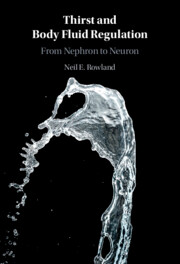Book contents
- Thirst and Body Fluid Regulation
- Thirst and Body Fluid Regulation
- Copyright page
- Contents
- Figures
- Preface
- 1 Fundamentals of Thirst and Body Fluid Regulation
- 2 Body Fluid Compartments, Inputs, and Outputs
- 3 Intracellular Dehydration Thirst and Drinking
- 4 Intracellular Dehydration: Mechanism
- 5 Extracellular Dehydration Thirst and Drinking
- 6 Pregnancy and the Ontogeny of Thirst
- 7 Food-Associated Drinking and Nycthemeral Rhythms
- 8 Hybrid Dehydrations: Water Deprivation
- 9 Hybrid Dehydrations: Thermal Stress and Exercise
- 10 Thirst in Aging and Clinical Populations
- 11 Comparative Aspects of Body Fluid Regulation
- Appendix Methods in Physiology and Neuroscience
- References
- Index
9 - Hybrid Dehydrations: Thermal Stress and Exercise
Published online by Cambridge University Press: 09 December 2021
- Thirst and Body Fluid Regulation
- Thirst and Body Fluid Regulation
- Copyright page
- Contents
- Figures
- Preface
- 1 Fundamentals of Thirst and Body Fluid Regulation
- 2 Body Fluid Compartments, Inputs, and Outputs
- 3 Intracellular Dehydration Thirst and Drinking
- 4 Intracellular Dehydration: Mechanism
- 5 Extracellular Dehydration Thirst and Drinking
- 6 Pregnancy and the Ontogeny of Thirst
- 7 Food-Associated Drinking and Nycthemeral Rhythms
- 8 Hybrid Dehydrations: Water Deprivation
- 9 Hybrid Dehydrations: Thermal Stress and Exercise
- 10 Thirst in Aging and Clinical Populations
- 11 Comparative Aspects of Body Fluid Regulation
- Appendix Methods in Physiology and Neuroscience
- References
- Index
Summary
Thermolytic responses are required in either high ambient temperatures, when conductive heat loss is low, or during states of increased heat production such as during exercise. Most of the thermolytic responses involve fluid loss, including panting (i.e., tachypnea) and evaporative cooling from skin moistened by sweating or saliva spreading. The relative contribution of these mechanisms is species dependent. In all cases, the principal systemic change produced by the fluid loss is hyperosmolarity, although hypovolemia can also be considerable. Humans and animals usually do not drink sufficient water to replace the lost fluid, resulting in a state of hypohydration. This can be partially mitigated by repeated exposure (i.e., adapation) or by providing electrolytes to drink. Sustained hypohydration and/or elevated core temperature produces loss of physical performance and, in the extreme, can be lethal. Available evidence siuggests that the OVLT and/or MnPO play important roles in detection of heat stress and execution of the thermolytic responses.
- Type
- Chapter
- Information
- Thirst and Body Fluid RegulationFrom Nephron to Neuron, pp. 164 - 186Publisher: Cambridge University PressPrint publication year: 2021

